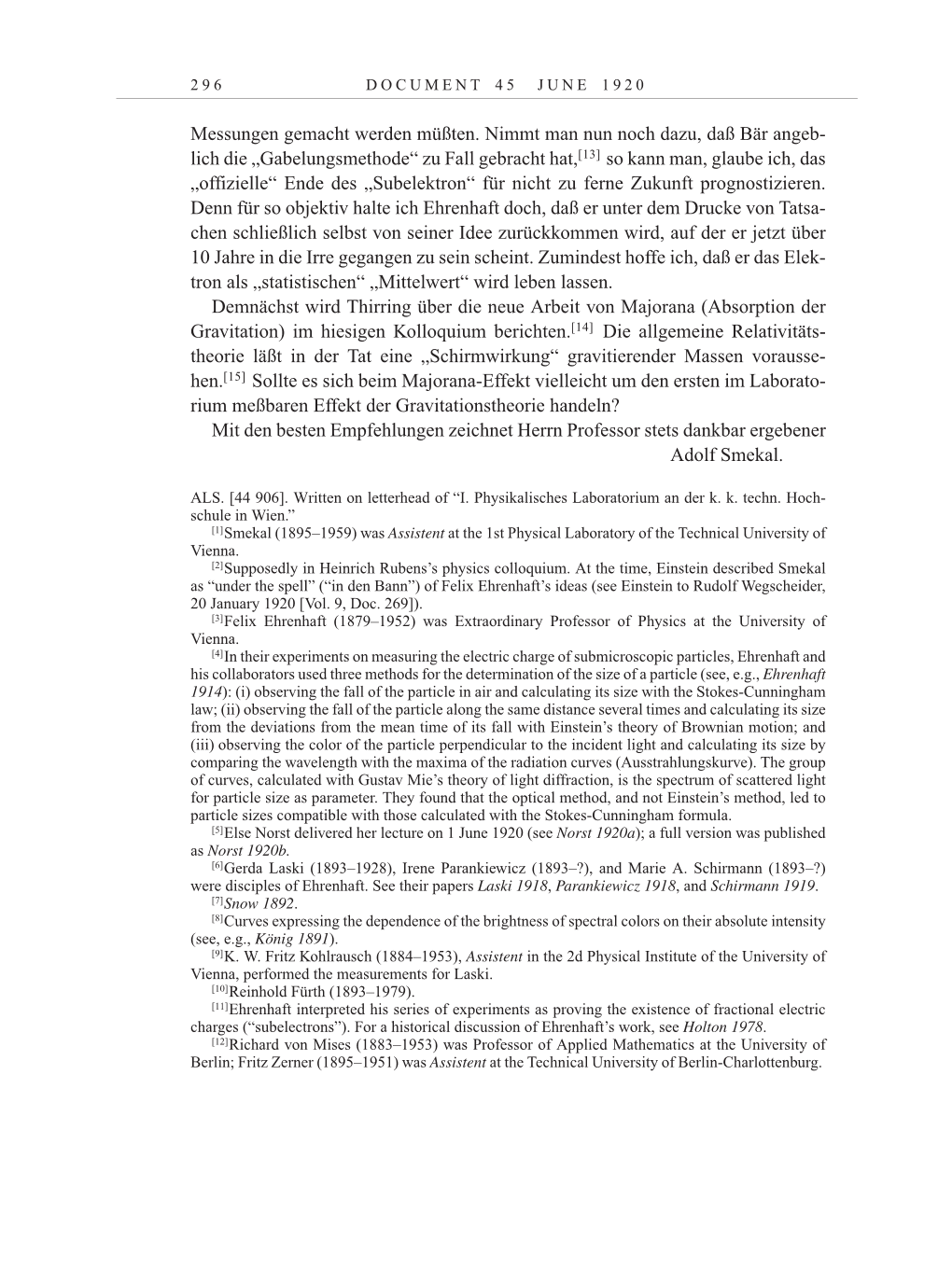2 9 6 D O C U M E N T 4 5 J U N E 1 9 2 0
Messungen gemacht werden müßten. Nimmt man nun noch dazu, daß Bär angeb-
lich die „Gabelungsmethode“ zu Fall gebracht
hat,[13]
so kann man, glaube ich, das
„offizielle“ Ende des „Subelektron“ für nicht zu ferne Zukunft prognostizieren.
Denn für so objektiv halte ich Ehrenhaft doch, daß er unter dem Drucke von Tatsa-
chen schließlich selbst von seiner Idee zurückkommen wird, auf der er jetzt über
10 Jahre in die Irre gegangen zu sein scheint. Zumindest hoffe ich, daß er das Elek-
tron als „statistischen“ „Mittelwert“ wird leben lassen.
Demnächst wird Thirring über die neue Arbeit von Majorana (Absorption der
Gravitation) im hiesigen Kolloquium
berichten.[14]
Die allgemeine Relativitäts-
theorie läßt in der Tat eine „Schirmwirkung“ gravitierender Massen vorausse-
hen.[15]
Sollte es sich beim Majorana-Effekt vielleicht um den ersten im Laborato-
rium meßbaren Effekt der Gravitationstheorie handeln?
Mit den besten Empfehlungen zeichnet Herrn Professor stets dankbar ergebener
Adolf Smekal.
ALS. [44 906]. Written on letterhead of “I. Physikalisches Laboratorium an der k. k. techn. Hoch-
schule in Wien.”
[1]Smekal (1895–1959) was Assistent at the 1st Physical Laboratory of the Technical University of
Vienna.
[2]Supposedly in Heinrich Rubens’s physics colloquium. At the time, Einstein described Smekal
as “under the spell” (“in den Bann”) of Felix Ehrenhaft’s ideas (see Einstein to Rudolf Wegscheider,
20 January 1920 [Vol. 9, Doc. 269]).
[3]Felix Ehrenhaft (1879–1952) was Extraordinary Professor of Physics at the University of
Vienna.
[4]In their experiments on measuring the electric charge of submicroscopic particles, Ehrenhaft and
his collaborators used three methods for the determination of the size of a particle (see, e.g., Ehrenhaft
1914): (i) observing the fall of the particle in air and calculating its size with the Stokes-Cunningham
law; (ii) observing the fall of the particle along the same distance several times and calculating its size
from the deviations from the mean time of its fall with Einstein’s theory of Brownian motion; and
(iii) observing the color of the particle perpendicular to the incident light and calculating its size by
comparing the wavelength with the maxima of the radiation curves (Ausstrahlungskurve). The group
of curves, calculated with Gustav Mie’s theory of light diffraction, is the spectrum of scattered light
for particle size as parameter. They found that the optical method, and not Einstein’s method, led to
particle sizes compatible with those calculated with the Stokes-Cunningham formula.
[5]Else Norst delivered her lecture on 1 June 1920 (see Norst 1920a); a full version was published
as Norst 1920b.
[6]Gerda Laski (1893–1928), Irene Parankiewicz (1893–?), and Marie A. Schirmann (1893–?)
were disciples of Ehrenhaft. See their papers Laski 1918, Parankiewicz 1918, and Schirmann 1919.
[7]Snow 1892.
[8]Curves expressing the dependence of the brightness of spectral colors on their absolute intensity
(see, e.g., König 1891).
[9]K. W. Fritz Kohlrausch (1884–1953), Assistent in the 2d Physical Institute of the University of
Vienna, performed the measurements for Laski.
[10]Reinhold Fürth (1893–1979).
[11]Ehrenhaft interpreted his series of experiments as proving the existence of fractional electric
charges (“subelectrons”). For a historical discussion of Ehrenhaft’s work, see Holton 1978.
[12]Richard von Mises (1883–1953) was Professor of Applied Mathematics at the University of
Berlin; Fritz Zerner (1895–1951) was Assistent at the Technical University of Berlin-Charlottenburg.
